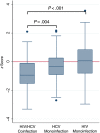Structural Bone Deficits in HIV/HCV-Coinfected, HCV-Monoinfected, and HIV-Monoinfected Women
- PMID: 25754980
- PMCID: PMC4548465
- DOI: 10.1093/infdis/jiv147
Structural Bone Deficits in HIV/HCV-Coinfected, HCV-Monoinfected, and HIV-Monoinfected Women
Abstract
Background: Coinfection with human immunodeficiency virus (HIV) and hepatitis C virus (HCV) is associated with reduced bone mineral density (BMD) and increased fracture rates, particularly in women. The structural underpinnings for skeletal fragility in coinfected women have not been characterized. We used tibial peripheral quantitative computed tomography to evaluate skeletal parameters in women, by HIV/HCV status.
Methods: We conducted a cross-sectional study among 50 HIV/HCV-coinfected, 51 HCV-monoinfected, and 50 HIV-monoinfected women. Tibial volumetric BMD and cortical dimensions were determined with peripheral quantitative computed tomography. Race-specific z scores for age were generated using 263 female reference participants without HIV infection or liver disease.
Results: Coinfected participants had lower mean z scores for trabecular volumetric BMD (-0.85), cortical volumetric BMD (-0.67), cortical area (-0.61), and cortical thickness (-0.77) than reference participants (all P < .001). The smaller cortical dimensions were due to greater mean z scores for endosteal circumference (+0.67; P < .001) and comparable z scores for periosteal circumference (+0.04; P = .87). Trabecular volumetric BMD was lower in coinfected than in HCV- or HIV-monoinfected participants. HCV-infected women with stage 3-4 liver fibrosis had lower mean z scores for trabecular volumetric BMD, cortical thickness, and total hip BMD those with stage 0-2 fibrosis.
Conclusions: Compared with healthy reference patients, HIV/HCV-coinfected women had decreased tibial trabecular volumetric BMD, diminished cortical dimensions, and significant endocortical bone loss.
Keywords: HIV; bone; coinfection; hepatitis C virus; peripheral quantitative computed tomography.
© The Author 2015. Published by Oxford University Press on behalf of the Infectious Diseases Society of America. All rights reserved. For Permissions, please e-mail: journals.permissions@oup.com.
Figures
References
-
- Brown TT, Qaqish RB. Antiretroviral therapy and the prevalence of osteopenia and osteoporosis: a meta-analytic review. AIDS 2006; 20:2165–74. - PubMed
-
- Rouillard S, Lane NE. Hepatic osteodystrophy. Hepatology 2001; 33:301–7. - PubMed
-
- Leslie WD, Bernstein CN, Leboff MS. AGA technical review on osteoporosis in hepatic disorders. Gastroenterology 2003; 125:941–66. - PubMed
-
- van Vonderen MG, Lips P, van Agtmael MA, et al. First line zidovudine/lamivudine/lopinavir/ritonavir leads to greater bone loss compared to nevirapine/lopinavir/ritonavir. AIDS 2009; 23:1367–76. - PubMed
Publication types
MeSH terms
Substances
Grants and funding
LinkOut - more resources
Full Text Sources
Other Literature Sources
Medical


